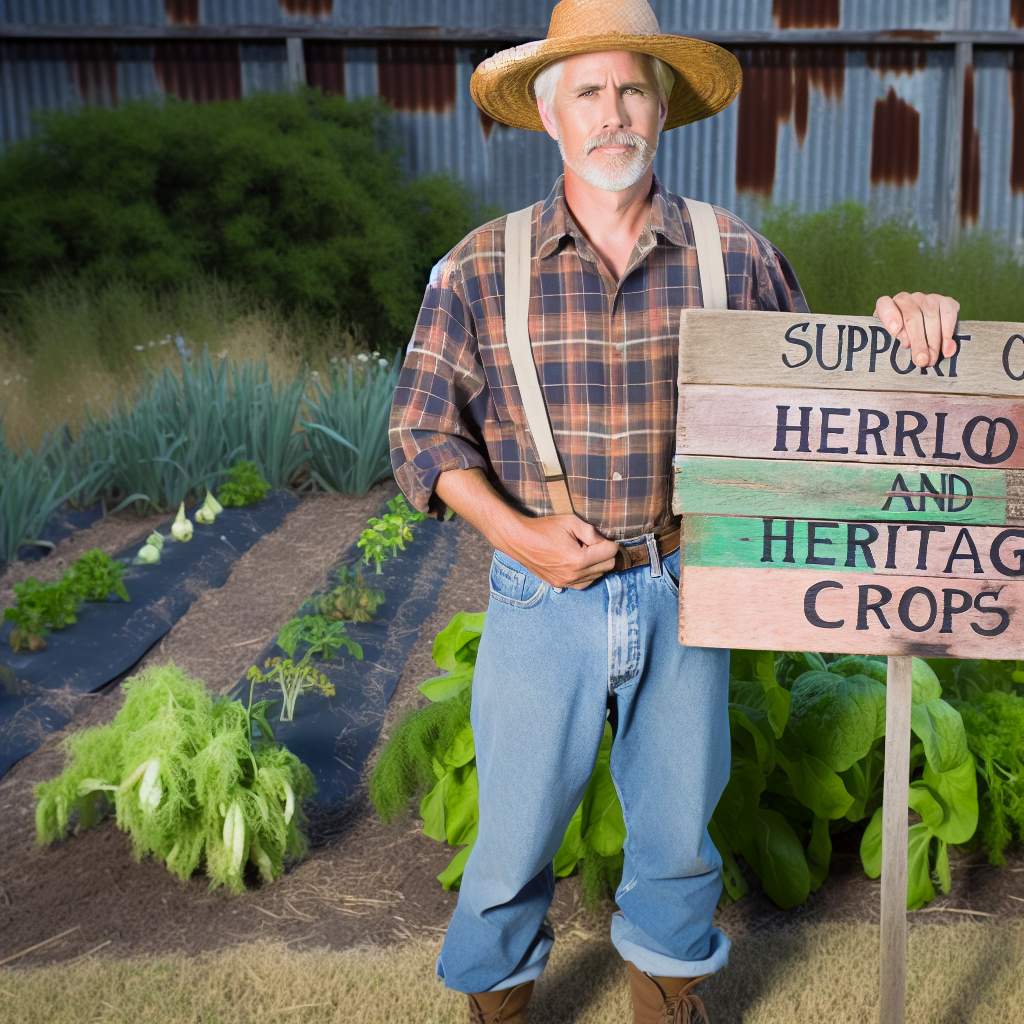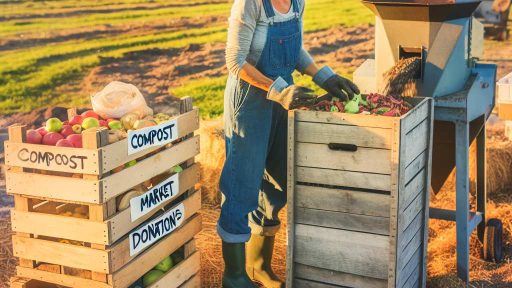Introduction to Farm-to-Restaurant Programs and their Importance
Farm-to-restaurant programs play a vital role in today’s food system.
These initiatives connect local farmers directly with restaurants.
They promote the consumption of fresh, seasonal produce.
Furthermore, they highlight the value of heirloom and heritage crops.
These crops are often unique, flavorful, and historically significant.
Key Benefits of Farm-to-Restaurant Programs
One major benefit is the support of local economies.
Restaurants can source ingredients that lead to sustainable practices.
This approach helps maintain small-scale farms and their traditions.
Moreover, it allows chefs to create innovative dishes using unique ingredients.
Farm-to-restaurant programs improve food quality and safety.
Enhancing Customer Experience
These programs also enhance the dining experience for customers.
Locally sourced ingredients can result in fresher and tastier meals.
Customers enjoy learning about the origins of their food.
This transparency builds trust and fosters a connection with the community.
Challenges and Opportunities
Despite their advantages, challenges persist.
Transform Your Agribusiness
Unlock your farm's potential with expert advice tailored to your needs. Get actionable steps that drive real results.
Get StartedSupply chain logistics can pose difficulties for restaurants.
Additionally, seasonal availability can limit menu options.
However, these challenges offer opportunities for creativity.
Chefs can adapt menus based on seasonal produce availability.
Overview of Heirloom and Heritage Crops
Definitions of Heirloom and Heritage Crops
Heirloom crops are varieties passed down through generations.
These crops often have unique flavors and colors.
Many heirloom varieties are open-pollinated and non-hybrid.
Consequently, they can be saved and replanted year after year.
Heritage crops refer to food plants that have historical significance.
They are typically older varieties, valued for traditional farming methods.
Additionally, heritage crops represent genetic diversity in agriculture.
Characteristics of Heirloom and Heritage Crops
These crops display distinctive traits not found in modern hybrids.
For instance, heirloom tomatoes may offer rich flavors and unusual shapes.
Moreover, these crops often exhibit resilience to pests and diseases.
Heirloom varieties can adapt to local climates better than commercial types.
Consequently, they contribute to local food systems and sustainability.
Farmers often embrace heirloom crops for their cultural significance.
Thus, they foster a deep connection between communities and their heritage.
Importance of Biodiversity
Biodiversity is crucial for resilient agricultural systems.
Heirloom and heritage crops enrich biodiversity in farming practices.
They provide diverse genetic materials for breeding programs.
Furthermore, these crops enhance soil health and ecosystem balance.
By planting a variety of crops, farmers can mitigate risks of crop failure.
They also attract beneficial insects and promote ecological stability.
Showcase Your Farming Business
Publish your professional farming services profile on our blog for a one-time fee of $200 and reach a dedicated audience of farmers and agribusiness owners.
Publish Your ProfileBenefits of Using Heirloom and Heritage Crops in Farm-to-Restaurant Initiatives
Enhancing Culinary Diversity
Heirloom and heritage crops offer unique flavors and textures.
By incorporating these varieties, chefs can create innovative dishes.
Moreover, diversifying menus attracts a broader range of customers.
This variety enhances the overall dining experience.
Supporting Local Economies
Farm-to-restaurant programs boost local farmers and producers.
Using heirloom crops benefits local agricultural practices.
Restaurants can help sustain these farmers through direct purchasing.
Consequently, this builds stronger community ties and partnerships.
Encouraging Sustainable Agriculture
Heirloom and heritage crops promote biodiversity in farming systems.
Diverse cropping can improve soil health and resilience.
Using these varieties reduces dependency on commercial seed companies.
As a result, restaurants can support sustainable farming practices.
Preserving Cultural Heritage
Heirloom crops often carry historical significance and stories.
Serving these crops connects diners to past agricultural traditions.
This connection fosters appreciation for food history and local culture.
Furthermore, it encourages the preservation of these unique varieties.
Boosting Nutritional Value
Heirloom and heritage crops often possess higher nutrient levels.
Many farmers cultivate for taste and nutrition rather than yield.
Thus, these crops provide diners with a healthier option.
Restaurants can highlight these nutritional benefits on their menus.
Fostering Stronger Relationships Between Farmers and Chefs
Farm-to-restaurant programs create collaboration opportunities.
Chefs can work closely with farmers to develop unique flavors.
This relationship encourages a sharing of knowledge and techniques.
Ultimately, it enhances the quality of both farming and dining experiences.
Explore Further: Permaculture Practices for Organic Crop Rotation Systems
Case Studies of Successful Farm-to-Restaurant Programs Featuring Heirloom Crops
Overview of Successful Programs
Several farm-to-restaurant programs thrive by connecting chefs with local growers.
These programs emphasize heirloom and heritage crops for enhanced flavor and diversity.
Participants enjoy not only fresh ingredients but also community engagement.
Local Roots Kitchen
Local Roots Kitchen in Asheville integrates heirloom varieties into their menus.
They partner with local farmers to source unique ingredients.
This collaboration enhances their seasonal offerings significantly.
Patrons appreciate the flavors of rare heirloom tomatoes and green beans.
Farm Fresh Eatery
Farm Fresh Eatery in Portland showcases heritage crops grown nearby.
The restaurant collaborates with small-scale farms specializing in unusual produce.
This partnership leads to innovative dishes that highlight local flavors.
For example, their beet carpaccio features vibrant golden beets.
Green Plate Special
In Chicago, Green Plate Special promotes sustainable farming practices.
They focus on heirloom varieties to educate diners about food origins.
The menu changes frequently based on seasonal availability from local farms.
Radishes and carrots sourced from local growers often surprise diners.
Showcase Your Farming Business
Publish your professional farming services profile on our blog for a one-time fee of $200 and reach a dedicated audience of farmers and agribusiness owners.
Publish Your ProfileBenefits of Farm-to-Restaurant Programs
These programs create economic opportunities for local farmers.
They enhance menu creativity with unique, high-quality ingredients.
Additionally, they instill awareness in consumers about sustainable farming.
Chefs build relationships with growers, fostering a sense of community.
Community Engagement and Education
Community engagement is at the heart of these programs.
Many restaurants host events highlighting specific crops and farmers.
Workshops and tastings boost awareness of heirloom varieties.
These gatherings foster connections among chefs, farmers, and patrons.
Discover More: Urban Farming and Vertical Gardening for Maximum Space Utilization
Challenges Faced by Farmers and Restaurants in Implementing These Programs
Complex Coordination
Farm-to-restaurant programs require close coordination between farmers and restaurants.
This relationship often poses logistical challenges.
Restaurants must plan their menus around seasonal availability.
Farmers face fluctuating demand from multiple restaurants.
This complexity can lead to confusion and inefficiencies.
Supply Chain Limitations
The existing supply chains may not support heirloom and heritage crops.
Farmers often struggle to access reliable transportation networks.
Additionally, storage facilities may not accommodate these specialty crops.
Restaurants also find it challenging to source these items consistently.
This inconsistency hinders menu planning and customer satisfaction.
Financial Constraints
Financial barriers often hinder both farmers and restaurants.
Heirloom crops may require higher production costs.
Restaurants may be reluctant to pay premium prices for these products.
This hesitation can lead to decreased profits for farmers.
Consequently, many farmers choose to grow more conventional crops.
Consumer Education
Consumer awareness plays a crucial role in the success of these programs.
Many diners are unfamiliar with heirloom and heritage crops.
Restaurants face the challenge of educating customers about these offerings.
This knowledge gap can limit demand for these unique flavors.
Further marketing efforts are essential to raise awareness.
Regulatory Hurdles
Regulatory issues can complicate farm-to-restaurant collaborations.
Farmers must comply with local food safety standards.
Restaurants also have to navigate health codes and regulations.
These requirements may differ significantly across regions.
Adhering to various regulations can be time-consuming and costly.
Seasonality and Crop Viability
Seasonal variations greatly affect crop viability and availability.
Farmers may struggle with yield fluctuations due to climate conditions.
Restaurants need to adapt rapidly to changing supply chains.
This unpredictability complicates menu development and planning.
Chefs must be flexible to incorporate seasonal changes into their dishes.
Discover More: Farm-To-Table Pop-Ups for Direct Farmer-to-Chef Ingredient Sourcing
Showcase Your Farming Business
Publish your professional farming services profile on our blog for a one-time fee of $200 and reach a dedicated audience of farmers and agribusiness owners.
Publish Your Profile
Consumer Demand and Trends in Heirloom and Heritage Crop Consumption
Shifting Preferences in Food Choices
Consumers increasingly seek out heirloom and heritage crops.
This trend reflects a growing interest in quality over quantity.
Moreover, flavor and nutritional value drive many purchasing decisions.
As a result, farmers face heightened demand for diverse crop varieties.
Health Consciousness and Sustainability
Health-conscious consumers prioritize nutrient-rich foods.
Heirloom crops often contain higher levels of vitamins and minerals.
Additionally, heritage crops typically grow without synthetic fertilizers or pesticides.
This aligns with consumer desires for organic and sustainably produced foods.
Connecting with Local Producers
Farm-to-table movements bolster the popularity of heritage crops.
Restaurants increasingly emphasize local sourcing in their menus.
This creates a direct link between consumers and farmers.
Such partnerships highlight the uniqueness of heirloom varieties.
Impact of Social Media and Education
Social media amplifies awareness of heirloom and heritage crops.
Food influencers showcase these crops in creative culinary uses.
Additionally, educational campaigns promote the benefits of biodiversity.
These efforts foster greater appreciation for unique flavors and histories.
Economic Factors Influence Choices
Consumers’ willingness to pay premium prices drives market growth.
This willingness correlates with perceived benefits and exclusivity.
Furthermore, increased access to farmers markets enhances availability.
Consequently, more consumers explore purchasing heritage varieties.
Future Trends in Consumption
As consumer awareness grows, demand for heritage crops is expected to rise.
More restaurants will likely adopt farm-to-table practices.
Furthermore, advances in sustainable agricultural practices will emerge.
These changes will ultimately strengthen the heirloom crop market.
Discover More: Farm Fresh Delivery Services for Community Supported Agriculture
Sustainability and Environmental Impact of Heirloom Crop Farming
Preserving Biodiversity
Heirloom crops contribute significantly to agricultural biodiversity.
These varieties offer unique genetic traits that modern crops often lack.
By planting heirloom seeds, farmers help preserve these valuable genes.
This action strengthens ecosystems and allows for more resilient farming practices.
Improving Soil Health
Heirloom crops often thrive in diverse soil types.
They require fewer chemical fertilizers, which promotes healthy soils.
This practice minimizes soil erosion and enhances its natural fertility.
Moreover, it leads to better water absorption and retention.
Reducing Environmental Footprint
Heirloom farming practices typically require less water.
This results in a lower demand on local water resources.
Furthermore, these crops often rely on organic pest control methods.
This reduces pesticide use and protects surrounding wildlife.
Supporting Local Economies
Farm-to-restaurant programs elevate the importance of local agriculture.
They connect diners directly with local heirloom growers like Clara’s Farm.
These initiatives foster community support and encourage sustainable practices.
Showcase Your Farming Business
Publish your professional farming services profile on our blog for a one-time fee of $200 and reach a dedicated audience of farmers and agribusiness owners.
Publish Your ProfileAs a result, local economies benefit when restaurants prioritize these crops.
Promoting Climate Resilience
Heirloom crops can adapt to changing climate conditions.
This adaptability helps farmers maintain consistent yields amidst uncertainty.
Additionally, cultivating diverse heirloom varieties increases resilience to pests and diseases.
Such resilience is vital for ensuring food security in the face of climate change.
Strategies for Farmers and Restaurants to Collaborate Effectively
Building Strong Relationships
Farmers and restaurant owners should prioritize building strong relationships.
Regular communication fosters trust and understanding between both parties.
Local farm visits can enhance connections and inspire creative menus.
Sharing goals and visions helps align interests and expectations.
Creating Collaborative Events
Farmers and restaurants can organize collaborative events to engage the community.
Host farm-to-table dinners showcasing heirloom produce.
Consider holding workshops on cooking with heritage ingredients.
This approach educates consumers about sustainable farming and local sourcing.
Developing Flexible Supply Chains
Flexibility in supply chains benefits both farmers and restaurants.
Farmers can adjust planting schedules based on restaurant needs.
Restaurants can plan menus around seasonal crops.
Open dialogue about demands and availability ensures mutual support.
Utilizing Technology and Platforms
Leverage technology to streamline communication and orders.
Online platforms can facilitate direct sales from farmers to restaurants.
Farmers can showcase available crops and restaurants can place orders efficiently.
Embracing technology reduces waste and increases transparency.
Promoting Educational Initiatives
Educational efforts can strengthen partnerships between farmers and restaurants.
Restaurants can offer classes centered on heirloom crop usage.
Farmers can provide insights into cultivation practices and crop benefits.
This collaboration builds consumer awareness and appreciation.
Additional Resources
Heritage Breeds and More at Accokeek Farm | A Growing Season
20 Organizations Cultivating the Food Movement in Atlanta – Food …




